MAYAPUR BHRAMAN
I've heard about Mayapur quite many times since I arrived
at Kolkata, however, never got a
chance of making a plan to this spiritual land earlier. But one fine day, our destiny called us to this divine
place. It was a sudden short trip to the 'Land of Kirtans' (Kirtans=religious
performers). We have visited the 'ISKCON', during our stay in Bangalore, when it was
newly built about a decade and a half ago, however, coming across the country or overall world 'The International Society for KrishnaConsciousness (ISKCON)' has been built in a lot
of other places too. Since my visit to Mayapur, I began to gather my knowledge
about this incredibly exponential Society. The first and foremost thing that made me
amazed and substantially feeling proud of is that the headquarters of ISKCON is
actually located in Mayapur, in my birth state of West Bengal. And the
founder of ISKCON - A.C.
Bhaktivedanta Swami, is the
disciple of the son of Bhaktivinoda Thakur and was actually born in Kolkata. There
are a number of pages in Wikipedia about
these spiritual reformers, which were quite interesting to know. However, let
me begin my day's journey to the spiritual land- 'The Kirtan Capital of the
World- Mayapur'.
It was in the
mid-December, very apt time to visit Mayapur, and also the peak season which is
in fact from November-March. We were
unaware about the pros and cons of the location
because we decided to visit in a very short span of time, people had
started booking at least one month
earlier, and it is very important to check for the vacancy online through mayapur.com. There are different modes of the transport system to take you over to the Holy Land, there
are daily buses directly from Kolkata to Mayapur and of course trains from Howrah and Sealdah are always available. We
planned to take our private family car with seven-seaters, and off-late
since a winter morning, we begin our journey around 7:40 am. It wasn't a busy
day in Kolkata, so we weren't restricted
to the traffic jam.
Around 9 am we
happened to cross Helabattala Barasat, enjoying the scenic views
by my side and the life of village settlers. It was a fresh revision to me
about my own state. Seeing the other side of West Bengal, going on our way
from Krishnagar Noapara, I realized that
my own native is really a beautiful
cultivating land which cultivates huge amount of
rice, sugarcane, mustard seeds, banana, cotton, brick-stones, etc. My state resembles a vast pride of culture, education, tradition, language etc,.
 |
| Paddy cultivation in Nadia (West Bengal) |
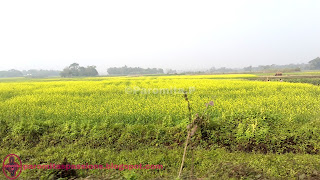 |
| Mustard Field |
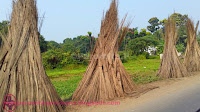 |
| Jute |
People of all religion resides in this town and there is no boundary for their worship home- St.Stephens Church. Just a little distance away falls one of the urban sided supermall- Sentrum mall, Forest range office at Ranaghat which falls on this long route of National Highway (NH 34).
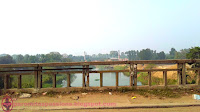 |
| Churni bridge |
 |
| Mango Plantation |
On passing the State Highway 3 (NH34), we come across plenty of
Mango trees planted over huge fields on both the sides of the road.
Now we were at a point of 3 directional way, at the leaving point of
Ranaghat town, on our Left-hand side falls
Santipur and towards our right-hand side is
Krishnanagar. We were heading to Krishnanagar (the name of this place has been
misspelled or miswritten as Krishnagar/Krishnanagar). Krishnagar is very famous
for burnt mud clay pottery such as clay pots, dolls, and models. On entering this town, we find whole lots of Mango
trees, and few more places to cross by this route were Gobindapur, Itla Kalirhat
Krishnagar, Chakdinagar in the Nadia district.
Finally,
we reached the Nabadwip more, thereby we were very close to our destination. We
crossed over the Jalangi Bridge on the Jalangi river, one of the tributaries of river Bhagirathi (a tributary of Holy river Ganga). Here comes a
point where the roads are non-concrete, and as the wheels roll on the dust, it
covers all the glass panes making everything invisible, so it is very important
to close the window panes on the entire route. Since these are remote areas the
roads are unsurfaced (kuchha), that is
why they are very dusty.
We witnessed a superfast train passing by, which I missed to capture in my camera, and for this, we had to wait for about 10 minutes on the way. We then entered Dharmkata, where you get to see the typical Gobar cakes been put on the walls of the houses and side walls for drying. But everything that you find here is pleasing to the nature's best at Belpukur with beautiful lush green fields on both the sides of the road. Many foreigners have been settled in these places building their own homes.
We come across Dargatala, a little further is Baamunpukur Bazaar, and finally, we reached Shri Mayapur, Nadia. It took almost 4 hours to travel a distance of 130 kilometers or even more from our house to Mayapur (Nadia district).
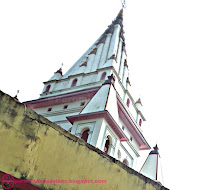
The first thing that comes on the way is the 'Satsang Vihar' at Mayapur. Since it was the peak season of the year, here onwards the crowd increased rapidly, people were rushing, hushing and bushing at each other, it was astoundingly surprising and very congested too.

We were clueless as to where do we park our car, and the guards were just trying to move us as quickly as possible to vacate the roads from getting a jam.
On the very opposite side to the magnificent Mayapur Iskcon
Temple, there was a huge area to park the
private cars. After parking, we got fresh and looked for lunch, as it was
already 12 past 10 minutes, and we all were stubbornly hungry. There are a lot
of eating and lunching outlets by 'Mahaprabhu's', which provide simple
vegetarian delicacies (Saatvik Bhojan). After filling our unrest tummy with the humble lunch, we
hired a 'Toto' (Tuktuk gaadi) for the
journey through the narrow lanes of Mayapur. Toto is 4 to 5 seater open van
which charges Rs.10 per person.
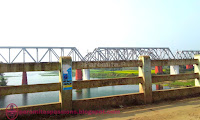 |
| Jalangi Bridge |
We witnessed a superfast train passing by, which I missed to capture in my camera, and for this, we had to wait for about 10 minutes on the way. We then entered Dharmkata, where you get to see the typical Gobar cakes been put on the walls of the houses and side walls for drying. But everything that you find here is pleasing to the nature's best at Belpukur with beautiful lush green fields on both the sides of the road. Many foreigners have been settled in these places building their own homes.
We come across Dargatala, a little further is Baamunpukur Bazaar, and finally, we reached Shri Mayapur, Nadia. It took almost 4 hours to travel a distance of 130 kilometers or even more from our house to Mayapur (Nadia district).

The first thing that comes on the way is the 'Satsang Vihar' at Mayapur. Since it was the peak season of the year, here onwards the crowd increased rapidly, people were rushing, hushing and bushing at each other, it was astoundingly surprising and very congested too.

We were clueless as to where do we park our car, and the guards were just trying to move us as quickly as possible to vacate the roads from getting a jam.
 |
| Toto Van |
 |
| Mayapur City |
MAYAPUR ISKCON TEMPLE
Mayapur city is at the confluence of two important rivers of West
Bengal, they are the Jalangi and the Hooghly. Mayapur is located on the banks of the tributaries of Holy river
Ganga. It is situated in the Nadia district of West Bengal and considered to be
one of the most sacred places worldwide.
The ISKCON Temple at Mayapur is said to be one of the largest in the world, and
if you visit at this time, you find the biggest temple is getting constructed and would be completed in a year or two.
The temple is been structured in the dome-shape
of the Vedic Planetarium, and this dome is the world's largest. Many devotees
from around the world travel to this spiritual place to pay their tribute to the
founder of ISKCON- Srila Prabhupada. The interiors of the temple are beautiful and serene, consisting of two
sections, where one part installs the idols of Radha-Krishna, and the other
section has the idols of Shri Chaitanya
Mahaprabhu and the Gaudiya Vaishnav Acharyas.
Mayapur city on the banks of the confluence of river Jalangi and Hooghly
Priests/Sevaks of the Temple and the Pilgrims on the Boat
We reached the Nabadwip Ghat, took our entry tickets for the
boat ride, which would take us through the Ganga river to the birthplace of
Shri Chaitanya Mahaprabhu.
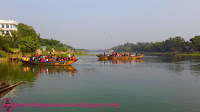 Many other boats also carried a crowd of people at the same time. Vast, huge,
deep- the sacred Ganges is distributed in its two tributaries- the Jalangi and
the Hooghly. And Mayapur falls at the banks of the confluence of these two
rivers.
Many other boats also carried a crowd of people at the same time. Vast, huge,
deep- the sacred Ganges is distributed in its two tributaries- the Jalangi and
the Hooghly. And Mayapur falls at the banks of the confluence of these two
rivers.
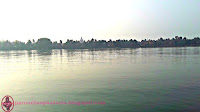 On crossing the Jalangi river at Mayapur, far
there we could view the temple
at Caitanya
Mahaprabhu's birthplace, and at
the right side is the Hooghly.
On crossing the Jalangi river at Mayapur, far
there we could view the temple
at Caitanya
Mahaprabhu's birthplace, and at
the right side is the Hooghly.
This is how the Nabadwip town looks like, one noticeable thing you won't
miss to find here is the Toto. We again hired two Totos for the 'Nabadwip
Bhraman', the Toto-wala was a simple and polite person, who rode us carefully
through the most narrow lanes and depressed routes. He took us to all the
temples one after the other and we paid our worship to the ancient city
temples.
 Many other boats also carried a crowd of people at the same time. Vast, huge,
deep- the sacred Ganges is distributed in its two tributaries- the Jalangi and
the Hooghly. And Mayapur falls at the banks of the confluence of these two
rivers.
Many other boats also carried a crowd of people at the same time. Vast, huge,
deep- the sacred Ganges is distributed in its two tributaries- the Jalangi and
the Hooghly. And Mayapur falls at the banks of the confluence of these two
rivers. On crossing the Jalangi river at Mayapur, far
there we could view the temple
at Caitanya
Mahaprabhu's birthplace, and at
the right side is the Hooghly.
On crossing the Jalangi river at Mayapur, far
there we could view the temple
at Caitanya
Mahaprabhu's birthplace, and at
the right side is the Hooghly.
Countless heads crossing through the holy river Ganga,
we came from the Jalangi river on our right side, Mayapur ISKCON can be seen in the center and Hooghly river flows down on the
left.
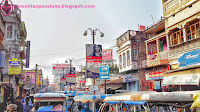 |
| Nabadwip town |
 |
| Radharani Mandir |
 |
| Artists are busy making new idols of the Gods. |
They charge an amount of Rs.5 for the maintenance of the temple and restore the medieval structures. These charges are nothing but they are been included as the Pronami (money given at the time of offering obeisance to the God). Pronami is a Vaishnavism traditional way to collect the homage paid to the saints by their believers within Hinduism. This tradition emerged from the 17th century in Eastern India, based on the teachings of Bhakti saints who genuinely followed and focussed on the preachings of Lord Krishna.
You find different display boxes where the idols have been displayed and each of these boxes represents stories of Lord Krishna and his different avatars such as Vishnu, also carvings of the Vaishnav saints- Mahaprabhu, Nityananda, and other Gaudiya Vaishnav Acharyas. There is a big hall for the visitors to sit and listen to the day-long devotional songs of Lord Krishna and Radha.
 |
| Maa Mansha Gandeshwari Mandir |
Next, we went to the 'Maa
Monsha Gondeshwari Mondir', a Hindu temple enormously devoted to the supreme
power of the Goddess. We had to leave our footwear
in the Toto-van because it is necessary
to enter the temple barefooted to keep the temple premises sacred and divine, also to keep the sanctity of the temple
pure, we need to wash off our legs at the tubewell present near the entrance of
the temple. After paying our worship, the Purohits distributed Prashadam to everyone. (Purohits= Priest,
Prasad= a devotional offering made to a God).
 |
| Shri Shri Nityananda Milan Mandir |
All these temples were just few distance away, taking about
5-8 minutes to reach the next one. 'Shri Shri Nityananda Milan Mondir' was the next
temple on our list that we visited, this temple is exclusively devoted to the
best friend of the founder of Vaishnavism (Mahaprabhu), and this place resembles
the meeting of these two great souls-
Mahaprabhu and Nityananda, who were also known as Gaura Nitai /Nimai-Nitai
and there names have always been taken together just like Lord Krishna and his
brother Balaram.
The next temple was one of the main of all the holy places
on this land, which is entirely devoted to the God founder head of Gaudiya Vaishnavism- Chaitanya Mahaprabhu. 'Shri
Shri Gouranga Mohaprobhu', we
offered our prayers and also took the Prashadam
(dry prasad). Here we aren't allowed to click any pictures, as the place is
very quiet and serene, prohibition of
photos have been entitled to not cause any disturbance in the meditation and
chanting to the name of the Lord. It is considered to be the Birthplace of Shri
Chaitanya Mahaprabhu, by the locals.
'Shri Shri Maa Dadar Gon' was the next Temple that we paid our homage, where the mother Goddess have been
living for ages. There were countless
other small and interesting to know about temples that we came across on the
way. Such one was the Shri Shri Lokhinarayan Temple, which is devoted to one of
the incarnations of Lord Vishnu, who is
the supreme creator of the universe- Shri Narayana and his wife Lakshmi.
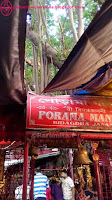 |
| Porama Mondir |
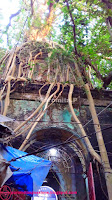 The inner portion of the temple is very dark and one has
to bend/ bow down while walking inside the temple, and it is considered to be
an auspicious blessing on taking at least 3 rounds inside this temple.
The inner portion of the temple is very dark and one has
to bend/ bow down while walking inside the temple, and it is considered to be
an auspicious blessing on taking at least 3 rounds inside this temple.
Our Nabadwip Yatra came to an end within a day, it would
hardly take 2 hours for the complete trip to
this island (Naba=nine, Dwip= island). It is a small town on the banks of holy river
Ganga, and there are innumerable temples belonging to the devotion of Lord
Vishnu and the founders of Vishnu Bhakts (Bhakts= devotee). People from all
over the world, especially the Vaishnavites religion visit this sacred place to
pay their homage at least once in a year.
The most important time to visit this place are in the months of February and March because of the Birthday of Shri
Chaitanya Mahaprabhu
celebrated as Gaura-Purnima,
and also its the crowdiest period of the year.
 |
| Mayapur ISCKON Temple |
Just before the sun was about to set, we returned to Mayapur
via boat by crossing the holy river. We did not
want to miss the famous evening Aarti of Shri Krishna (Sandhya Aarti) at 06:30 PM.
 We had quite sufficient time
to go around in the beautiful and vast
flower garden at the back lawns of the main Temple.
We had quite sufficient time
to go around in the beautiful and vast
flower garden at the back lawns of the main Temple.
 There are many small
eateries been installed for the quick snacks before entering the main temple. This
sacred place organizes different cultural
and mythological festivals throughout the year, however,
December and January are the best months
to visit with the prior booking of the hotel to this place. Millions of people visit this place during the
Ratha-Yatras and Holi, numerous offerings are been made to the Lord.
There are many small
eateries been installed for the quick snacks before entering the main temple. This
sacred place organizes different cultural
and mythological festivals throughout the year, however,
December and January are the best months
to visit with the prior booking of the hotel to this place. Millions of people visit this place during the
Ratha-Yatras and Holi, numerous offerings are been made to the Lord.
When we went, there was a 'Gita Mela' organized at the back lawns of the main temple (Gita= songs, Mela= Fair).
 Beautiful
Rangolis have been made with flowers at many places within the premise.
Beautiful
Rangolis have been made with flowers at many places within the premise.
These elephant chariots were decorated with different varieties of colorful
flags, festoons, banner etc, and they go around the whole temple premises to
spread the holy Sandhya Aarti.
Before entering the main temple, we need to keep in mind, not to carry our cell phones or cameras inside. There is a big
section for storing our belongings just outside
the temple with a long queue submitting their cell
phones along with owners name and also the complete family's footwear in a gunny bag. They pile up the
things properly and securely in different sections. After depositing our
belongings, we washed our hands and legs
and then began queuing up in the line to enter the main temple. Crowds gathered raising both their hands at all
the ends of the temple hall, and it was a blissful
moment.
 We had quite sufficient time
to go around in the beautiful and vast
flower garden at the back lawns of the main Temple.
We had quite sufficient time
to go around in the beautiful and vast
flower garden at the back lawns of the main Temple. There are many small
eateries been installed for the quick snacks before entering the main temple. This
sacred place organizes different cultural
and mythological festivals throughout the year, however,
December and January are the best months
to visit with the prior booking of the hotel to this place. Millions of people visit this place during the
Ratha-Yatras and Holi, numerous offerings are been made to the Lord.
There are many small
eateries been installed for the quick snacks before entering the main temple. This
sacred place organizes different cultural
and mythological festivals throughout the year, however,
December and January are the best months
to visit with the prior booking of the hotel to this place. Millions of people visit this place during the
Ratha-Yatras and Holi, numerous offerings are been made to the Lord.When we went, there was a 'Gita Mela' organized at the back lawns of the main temple (Gita= songs, Mela= Fair).
 Beautiful
Rangolis have been made with flowers at many places within the premise.
Beautiful
Rangolis have been made with flowers at many places within the premise.
There
were different displays of idols depicting the stories of Shri Bhagavadgita (Hindu's sacred book).
Temple of one of the Saints Ruler
The priests
and other Bhakts are doing the Parikrama on the elephants during the time of Sandhya
Aarti.
After offering
our Sandhya Aarti to the almighty, we visited the 'Pushpa Samadhi Mandir', the
sacred tomb of Srila Prabhupada, who is the founder of the ISKCON or the Hare
Krishna movement. Its a beautiful building with a flower-shaped construction to pay tribute to the sacred soul.
Since this had been our first and unplanned
visit, we hadn't researched much about this place, and also the magnificent
structure is in the construction mode at this moment, we decided to pay our
visit once again in the coming year after the completion to one of the world's biggest
temple that is in the making. There is still much more to explore in my own beautiful state.
Author: Paromita PramanickReference: Few information from the linked websites.
Other Travel Stories on this blog-->> My 12 Days in Jammu and Kashmir , My first visit to the North-East
Paromita Pramanick ©2018. All Rights Reserved.

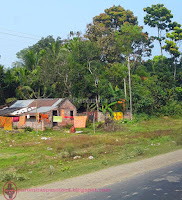

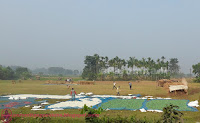





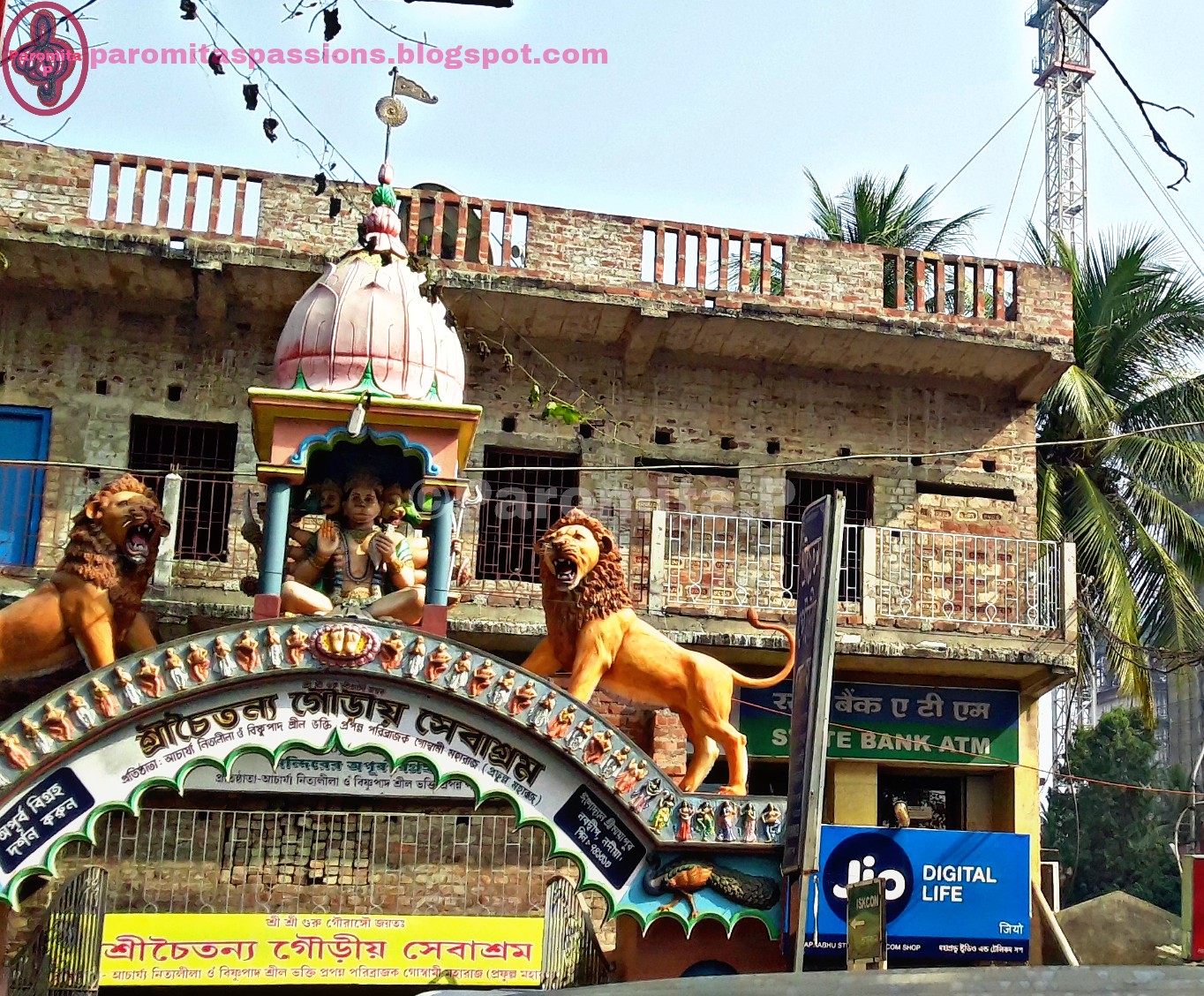
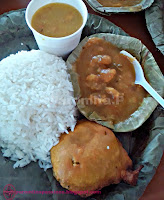



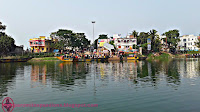

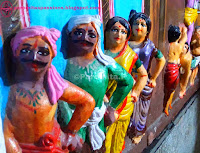

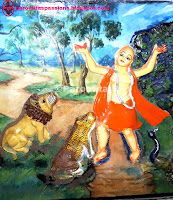
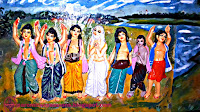










No comments: